Kirin Ichiban is a mega-popular Japanese beer brand from one of its pioneers. If you find Sapporo and Asahi a little too light for your taste, Kirin may be the beer for you.
In this article, I review this legendary biru, where and how it’s made, the ingredients, retail and delivery options, similar beers, serving suggestions, and more.
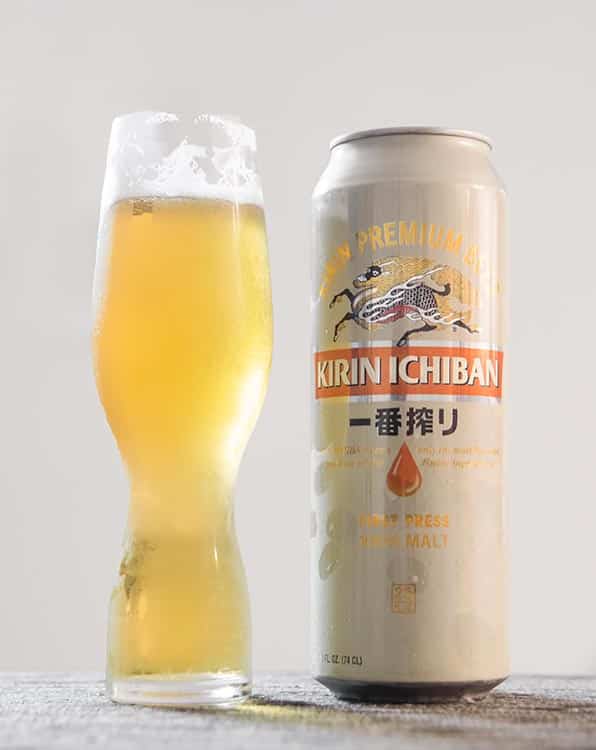
Kirin Beer Overview
Kirin has a few reasons why it’s one of the most interesting Japanese beers on the market. This is due to a combination of rich history, quality ingredients, and innovation.
Spring Valley, Kirin, & the Birth of Japanese Beer
Long before the Kirin brand existed, William Copeland, a Norwegian-American brewer, started the Spring Valley Brewery. He founded the brewery in 1869 in the Yamate foreign residential neighborhood of Yokohama. At this time, beer was almost entirely unknown in Japan.
Copeland chose a site on a natural spring adjacent Amanuma Pond. He dug a cave into the hillside to cold-ferment (lager) his beers, as well. His Germanic beers were popular among the Westerners in the area. Unfortunately, the Spring Valley Brewery still closed in 1884.
The Japan Brewery was founded to purchase the Spring Valley Brewery. And a few years later, they released the Kirin beer brand. They would eventually change their name to the Kirin Brewery.
This rich history makes the Kirin Brewery the oldest surviving beer brewer in Japan.
All-Malt Lager
Kirin Ichiban uses 100% malted barley for its grain bill. This differentiates it from rivals Sapporo and Asahi Super Dry which also use rice and corn. Being an all-malt lager, Kirin is closer in profile to its Germanic roots. It also has more flavor and body for this reason.
Is Kirin a Rice Beer?
Kirin Ichiban does not have rice. It’s an all-malt beer. They say it right on the can!
I’m repeating myself to get the point across because there is a lot of inaccurate info out there. Even from well-respected outlets (Food & Wine?!).
Why does it matter? Well, a beer brewed with rice tastes lighter and thinner. Rice can also be intentional, but usually, it’s a cheap filler in low-cost lagers. Kirin Ichiban clearly states it’s 100% malt because they want you to know it’s made with superior ingredients.
Getting it right is also important out of respect for people with certain dietary issues.
Ichiban Shibori: First Press
Kirin Ichiban uses the unique ichiban shibori (first press) wort filtration method. Most worts are pressed twice. This eliminates the more bitter and intense second pressing. It doesn’t mean the Kirin Ichiban is better, but it does produce a clean and elegant profile.
If it weren’t for the ichiban shibori method, Kirin beer would be fuller-bodied and more bitter.
Kirin Ichiban Meaning
The name Ichiban means “first” and “best” in Japanese. This refers to the ichiban shibori wort pressing method described above. Kirin isn’t saying that the beer is the best. Rather, the first press is the best.
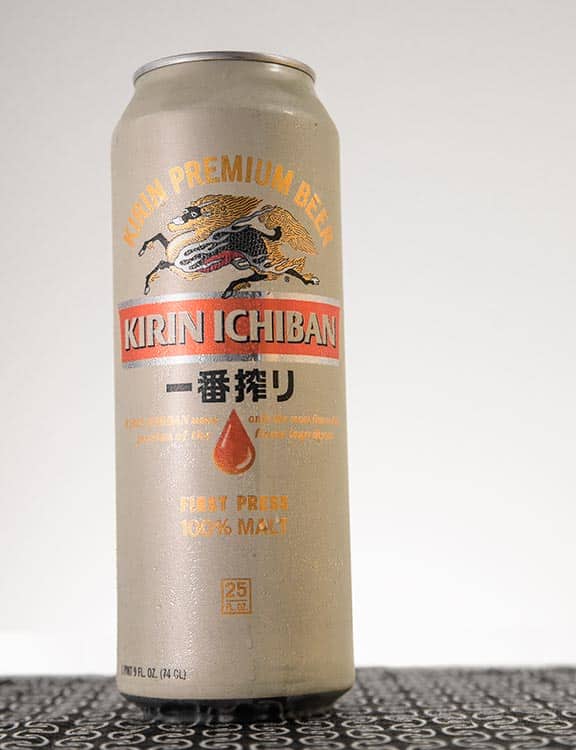
Finding and Buying Kirin Ichiban
Kirin Ichiban is available across the United States at retailer shops and grocers. Many Japanese restaurants and izakaykas carry it, as well. It’s typically available in bottles. It’s less common on-tap, but this is the optimal way to enjoy this beer when possible. Pricing for Kirin is reasonable.
Many grocers carry Kirin, as well. Japanese and Asian grocers often carry many of the mainstream Japanese beers. And Kirin is so popular that it turns up at regular grocery stores everywhere.
In its native land, Kirin Japan produces a lot of Kirin Ichiban Shibori, and it can be found easily. Also look out for their original Kirin Lager, Grand Kirin IPA, and even Kirin Green Label (happoshu).
If you want to enjoy this classic Japanese beer today, check out the online retailers below.
Shop Kirin Ichiban
We may earn commissions from qualifying purchases.
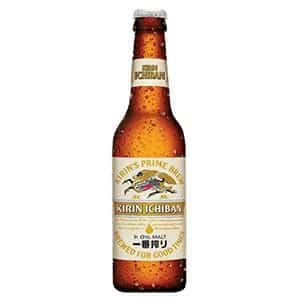
Kirin Ichiban Tasting Notes
Kirin Ichiban is made in the international pale lager style.
This clear lager has a copper color and modest head-retention.
The aromatic intensity of Kirin is restrained. Lightly toasted and honeyed malt is balanced by floral hop notes. Other descriptors include bubblegum and fresh hay.
The flavor of Kirin Ichiban is dry, medium-light in body, and modestly bitter. It has a soft texture and moderate carbonation. Tasting notes include toast, fresh bread, fresh flowers, and savory hops.
Compared to it’s other large rivals, I think Kirin Ichiban has more character and depth. That’s why it was an easy choice for my top Japanese beers article.
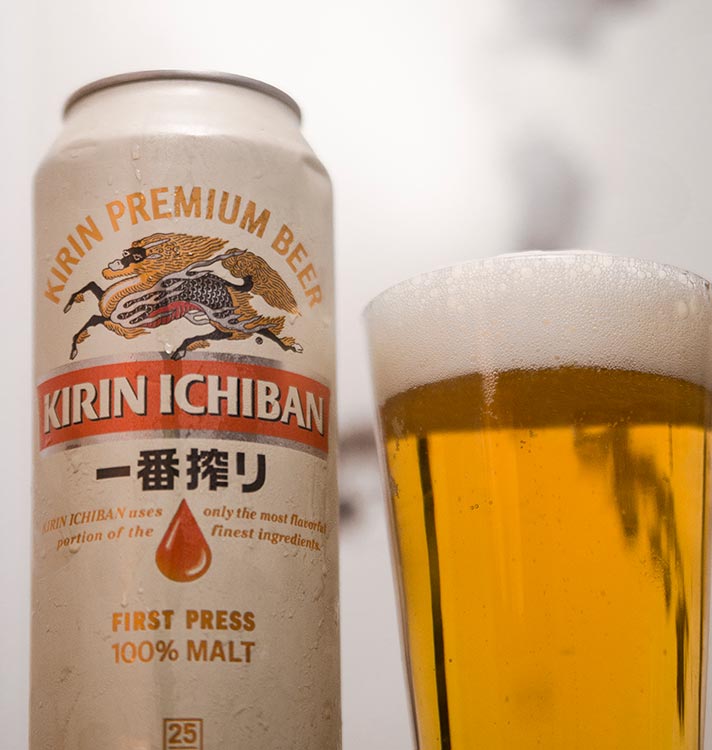
Recommended Beer Glasses
As an Amazon Associate I earn from qualifying purchases.
Serving Kirin Beer
Kirin Ichiban is best served from cold to chilled and in a glass. Ice-cold temperatures will make Kirin taste lighter. Serving with just a slight chill will open up more of the aromas and flavors. This can be done quickly by pouring fridge-temperature beer into a room temperature glass.
The ubiquitous sake bomb is popular among younger drinkers and Kirin is a solid choice. For safety reasons, a sturdy sake glass should be used.
Proper Beer Storage
All beer should be stored cold. This applies to Kirin Ichiban as well.
Beer has a short shelf-life. Keeping it cold will help prolong its freshness. And even cold beer can decline quickly, so fresher is better. A year-old Kirin is usually near the end of its life.
Light contact is also bad for beer and can create skunky aromas. Cans and kegs are safe, but glass isn’t nearly as effective. Luckily, Kirin Ichiban bottles use brown glass, which offers the most protection from light.
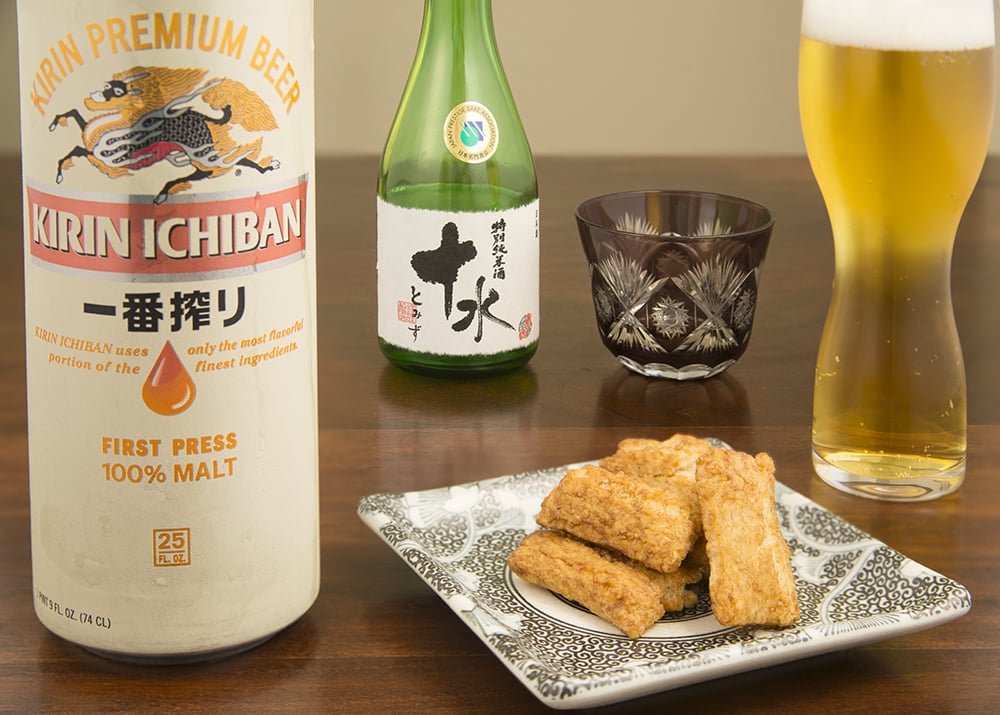
Pairing Kirin Ichiban with Food
Kirin is a refreshing, savory, and medium-light – making it a good all-round beer with Japanese cuisine.
It will effectively scrub away full-flavored cuts of fish like saba (pickled mackerel), sawara (spanish mackerel), salmon, yellowfin tuna, and black cod. These will taste good with Kirin as sashimi or nigiri.
Tempura is fantastic with Kirin and other macro-lagers. Other fried Japanese dishes like chicken karaage, tonkatsu, and takoyaki are also tasty with this beer. Other items to pair with Kirin Ichiban include hamachi kama, saba shioyaki, and yakitori.
Kirin is also adept at pairing with snacks. These are known by various names like shuko, otsumami, and sakana. Kirin Ichiban is awesome with okaki, konbu chips, edamame, and most dashi-flavored snacks.
Outside of Japanese food, try Kirin Ichiban with tangy and mild cheeses, seared scallops, fish tacos, chicken salad, and bratwurst.
Where is Kirin Beer Made?
Kirin’s original brewery was in Yokohama, Japan. Today, Kirin Japan operates breweries across the country. Locations for Kirin Japan breweries include Yokohama (Kanagawa), Chitose (Hokkaido), Kobe (Hyogo), Sendai (Miyagi), Nagoya (Aichi), Okayama, Toride (Ibaraki), Shiga, and Fukuoka.
The massive Kirin company also has their beers contract brewed across the globe. Anheuser-Busch InBev produces Kirin for the US market in Los Angeles, California.
Kirin’s beers are also produced in Germany, Australia, Southeast Asia, and China.
Kirin Holdings also brewed beer in Myanmar under a joint venture with the Myanmar and Mandalay Breweries. However, due to the recent (2021) military coup, Kirin has ceased this partnership. According to Kirin, they hope to brew beer in the country again at some point after the human rights abuses by the military are resolved.
Kirin Brewery Yokohama
If you’re visiting Tokyo or Yokohama, it’s worth checking out the Kirin Brewery Yokohama. You’ll have the opportunity to handle the raw materials used to make Kirin beer, witness the brewing process, and taste Kirin beers.
You can also take Kirin Ichiban brewery tours at their other breweries in Japan.
All tours are only in Japanese. Check out this link for more info on Kirin brewery tours.
Tours are temporarily suspended during the Covid-19 pandemic.
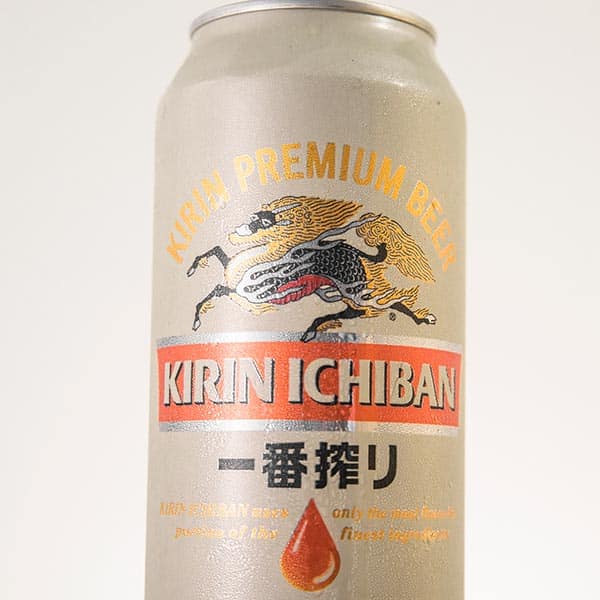
Kirin Ichiban Technical Info
Style: International Pale Lager
Mash Bill: malted barley, hops, water
Hops: unknown
ABV: 5% IBU: 19
Brewed year-round
Is Kirin Beer Gluten-Free?
Kirin Ichiban is not gluten-free. It is made with malted barley, which contains gluten. Therefore, celiacs and those with gluten intolerance should not drink this beer.
To be safe, it’s worth pointing out that the vast majority of Japanese rice beers still contain gluten.
In general, cheap, industrial lagers are usually the beers with the lowest gluten content. Rice, corn, and corn syrup are common ingredients. And they’re not as bad as advertised. But despite these gluten-free adjuncts, these beers will always have at least some malted barley.
So if you’re on a low gluten diet but craving a beer, these are good options. If you’re a celiac, you probably know your way around this subject. But just in case, avoid all beer that’s not specifically labeled as gluten-free.
Similar Beers to Kirin Ichiban
Kirin Ichiban’s most obvious rivals are Sapporo Premium and Asahi Super Dry. Kirin has more body and complexity than both.
Sapporo Reserve is a closer competitor, as it’s made with all-malt too. Both are good beers, but again Kirin is a bit more complex than the Sapporo. Yebisu a classic brand that is a great alternative to Kirin, but it’s not available in North America.
Orion Draft is another popular mainstream Japanese beer. It is arguably more complex than Kirin, but also a bit lighter in body.
In Japan, Kirin Lager is the original brand from Kirin. It is a bit grainier but similarly complex and delicious.
Craft Japanese lagers like Baeren Classic, Echigo Koshihikari, Codedo Ruri, and Hitachino Nest Lager are all highly recommended alternatives to Kirin. Each one of these beers will be more expensive and harder to get, however.
Non-Japanese beers that are somewhat similar to Kirin include Heineken and Carlsberg. Finally, German Pils-style beers are great alternatives and generally more complex and flavorful.
Kirin Light
Kirin Light is a low calorie and low strength pale lager. It has an alcohol content of 3.3% and only 95 calories. This makes it a sessionable and easy-drinking beer. Not surprisingly, it’s also very light in flavor. Hop bitterness is restrained.
Kirin Light is a good option for someone looking to watch their weight or are mildly gluten intolerant. Its low alcohol content also means that this beer is much less potent than the vast majority of beers.
For the US market, Kirin Light is brewed by Anheuser-Busch InBev in southern California.
Shop Kirin Light
We may earn commissions from qualifying purchases.
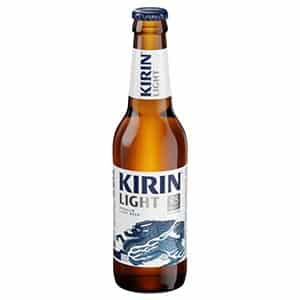
About Kirin Beer
Kirin beer has been around since 1888. At that time, it was a product of the Japan Brewery Company. The brewery would later change its name to the Kirin Brewery.
Since then, they’ve grown into a giant. And today, the Kirin Brewery Company is a global heavyweight. They’ve expanded to producing whisky, soft drinks, pharmaceuticals, engineering, real estate, agribio, and more.
Kirin Beer History – Spring Valley Brewery
Predating Kirin and the Japan Brewery Company was the Spring Valley Brewery. This brewery was established by Norwegian-American William Copeland in 1869. His brewery manufactured and sold beer to the Westerners in the Yamate foreigners residential district of Yokohama.
Copeland chose a site with a spring adjacent Amanuma Pond. He dug a cave into the hillside in order to produce German-style lagers year-round. His beers were a huge success among the locals. Spring Valley Brewery beers also helped introduced the foreign beverage to Japan.
The brewery would eventually fail. It was bought up by a group of Japanese investors and renamed The Japan Brewery in 1885. The company brought in a German brewmaster to lead its brewing team. They would release Kirin Lager a few years later.
With the help of Meidi-Ya grocery chain, Kirin was introduced increasingly across Japan. The Japanese were not accustomed to the taste of this bitter, foreign beverage. However, it slowly gained acceptance, and Kirin was eventually successful.
Recently, Kirin reintroduced the Spring Valley brand. But for now, they’re only available in Japan.
The Kirin Beer Logo
The Kirin, or Qilin, is a mythical creature in eastern Asia. Its roots are in Chinese mythology. And seeing one is considered a sign of good fortune.
Kirin chose this as their logo in a nod to the European brewery practice of putting animals on their labels. And at a time when beer was still largely foreign to the Japanese populace, the Kirin was a familiar creature.
Conclusion
Well, that’s a lot of Kirin info. Did I leave anything out?
And I’d love to hear how you think Kirin Ichiban stacks up against other major Japanese beers.
And if you’re not sure where to go next, check out more of my popular Biru content.
Kirin Ichiban, Premium is by far the worst beer I ever drank! Obviously, their German Brew master was not qualified to brew beer in Germany, that is probably the reason he ended up brewing beer in Japan.
You are biased. What is it you didn’t like about it?
Have you ever tried Coors light or Budweiser? Do you find them better than this beer?
Coors Original and Bud are comparable to Kirin Ichiban. They’re better values, but I think Kirin is slightly more complex. Coors Light is more watered down. But that’s not always a bad thing.
Then you haven’t consumed much beer. I’ve gad everything under the sun and Kirin is a light refreshing brew